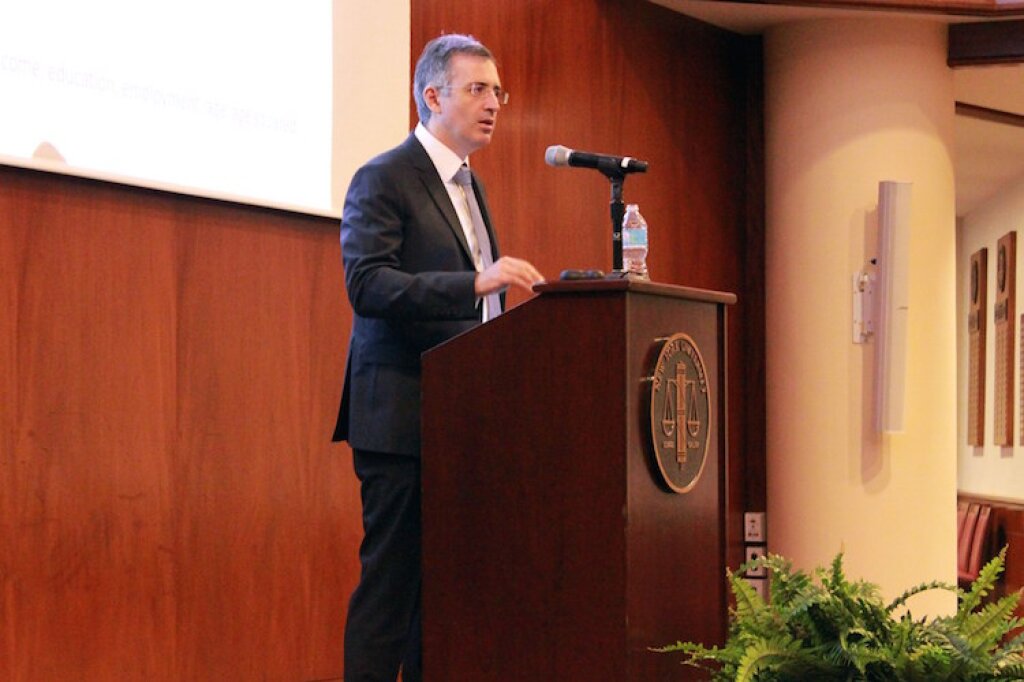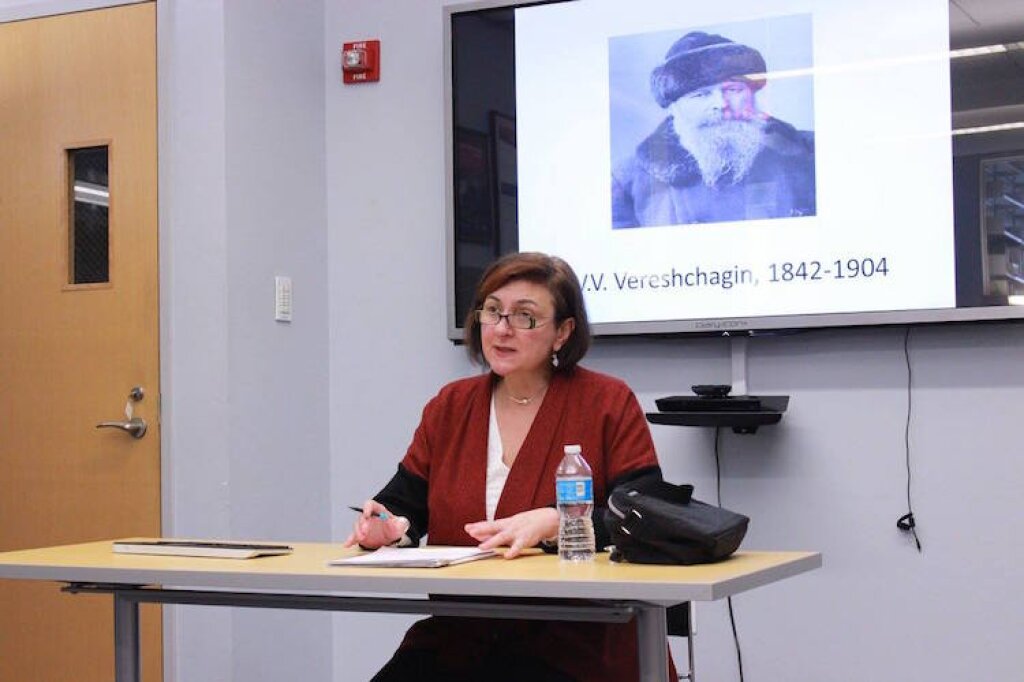On October 6th, Fabrizio Fenghi of Brown University joined the Jordan Center to speak about the National Bolshevik Party (NBP) and it’s legacy in his talk, “It Will Be Fun and Terrifying: Nationalism and Protest in Post-Soviet Russia.”
He introduced the topic by tracing the roots of Post-Soviet protest movements in Russia, beginning with the “August Coup” in August of 1991 which produced the now famous image of Boris Yeltsin speaking to protesters from his position on a tank.
Two years later, protesters occupied the White House during the Constitutional Crisis. The standoff resolved violently and constituted the “original sin” of Russian democracy. Fenghi explained that the resulting constitution gave the Russian president almost unlimited powers and paved the way for Putin’s authoritarian regime years later. As a result, a “red-brown” opposition, which included paradoxically diverse elements like leftists, Stalinists, and skinheads, emerged and created a vibrant counterculture that was reflected in postmodern literature like Victor Pelevin’s famous novel, Generation P.
Fenghi discussed the founding fathers of this counterculture, including Aleksandr Dugin, Eduard Limonov, Sergey Kurekhin, and Egor Letov, the lead singer of Siberian punk band “Civil Defense.” Limonov, a controversial underground writer and poet became well known for his semi-autobiographical work It’s Me, Eddie that depicted graphic sexual encounters with both men and women. His work, Memoir of a Russian Punk, reflected his fascination with the criminal world and aggressive masculinity and painted a bleak picture of life in the periphery of the USSR during the Thaw period.
Dugin developed a reputation as an underground mad, mystical artist-philosopher. Fenghi explained that Dugin was fascinated with fascism, both cultural and political, and claimed that he would be the Merlin to Limonov’s Arthur of the NBP.
Kurekhin was an avant-garde musician and performer best known for his televised hoax, “Lenin Was a Mushroom.” This and other performances, Fenghi clarified, were part of a genre called styob, a brand of parody which is best known for its over-identification with its object. Fenghi suggested that Kurekhin’s participation in the radical political movement was a final performance but admitted that Kurekhin’s real views are difficult to determine.
The NBP began to “invent” a Post-Soviet countercultural aesthetic through its newspaper, Limonka. The newspaper embodied the paradoxical identities of its members: punk, revolutionary. It took inspiration from the Russian and Italian avant-garde, authoritarianism, and punk and heavy metal. Their purpose, according to Dugin, was to “die beautifully.” The printing of Limonka, Fenghi explained, served as a community building exercise.
The flag of the NBP drew on Soviet and Nazi aesthetics: a black hammer and sickle on a white circle against a red background. The NBP also appropriated Soviet propaganda posters and slogans such as “Stand up, damned of the Earth.” The NBP provided an “oasis,” an alternative space for youth, that provided free concerts, performances, readingsm, and lectures at the “Bunker.” Later, the Putin regime, Fenghi explained, made attempts to appropriate the space taken up by the NBP and other nationalist movements through the youth pro-government movement, Nashi.
In the early 2000s, NBP members began to participate in “direct actions,” including “Strategy 31,” a movement in which members protested on the 31st of each relevant month to advocate for Article 31 of the Russian constitution which theoretically guarantees freedom of assembly. Other actions included an attempt to seize power in the Altai region, but the group only managed to purchase rifles, and some “members” were actually undercover Russian intelligence agents. They became known for their “street-avantgarde,” peaceful “performances,” including Strategy 31, earning the sympathy of journalists like Anna Politkovskaya who was assassinated in 2006.
The legacy of the NBP includes groups who use “art-activism” and performance protest in opposition to the Putin regime like Voina, a street art group, and Pussy Riot, a punk rock and performance group. NBP members were also involved in the 2011 protests at an early stage, though Limonov distanced himself from them, claiming that they weren’t radical enough.
Another legacy of the NBP has been Dugin’s conservative postmodernism. Dugan became a staunch supporter of Putin as someone who can restore Russia’s former imperial glory. His famous book The Fourth Political Theory defines Eurasianism as the dark side of postmodernism, a strategy based on embracing and bringing postmodern culture to its extreme conclusion with the goal of destroying modernity and the modern world. Dugin theorized that the Internet would be a great instrument for this political strategy and activity, and he has embraced this strategy by embodying different public personas.
Dugin’s Eurasianist movement, whose identity is developed on the model of Ivan the Terrible’s Oprichnina who persecuted any possible conspirators against the Tsar, is a minority movement compared to NBP, Fenghi said. It’s based on media strategies and the Internet.
More recently, Nationalist Bolsheviks have fought in Eastern Ukraine, fulfilling their dreams of fighting, reconquering Soviet territory, and rebuilding the Soviet Union. Dugin has also produced his “Guidelines,” a two-minute presentation packaged as a serious, journalistic piece, on the American presidential elections.
During the Q&A, Fenghi addressed the connections between styob and right wing dis/mis-information campaigns. He argued that, though there are certain overlaps in the way styob was used in the 90s, the fundamental difference between the two is the ability for peddlers of dis/mis-information today to remain anonymous.
Fenghi also expanded upon Dugin’s invocation of postmodernism. He explained that Dugin is attempting to reappropriate leftist critical theory, which translates into a move away from authenticity. For Dugin, postmodernism is an enemy because modernity is an enemy. Fenghi said that Dugin uses the Moscow theater hostage crisis as an example. According to urban legend, he explained, many of the audience members thought the hostage-takers were part of the spectacle until the violence began. In a similar fashion, Dugin argues, the rest of the world will eventually “understand” that the Eurasianists are “serious.”
Fenghi finally discussed the scale and constituency of the NBP and Eurasia movement. At its peak in the early 2000s, Fenghi said, there were probably between 1000-5000 thousand members. Constituency varied very much, and the organization was not rigidly structured. In the provinces participants might have been skinheads, hooligans, neo-Nazis. He argued that the numbers were less important than the commitment of its members—commitment and media strategy allowed them to accrue more influence. The Eurasian movement has never managed to have an actual constituency; rather its influence exists as a massive presence on the Internet, and it manages to attach itself to larger state sponsored movements like Nashi and more recently the National Liberation Movement (NLM or NOD).


